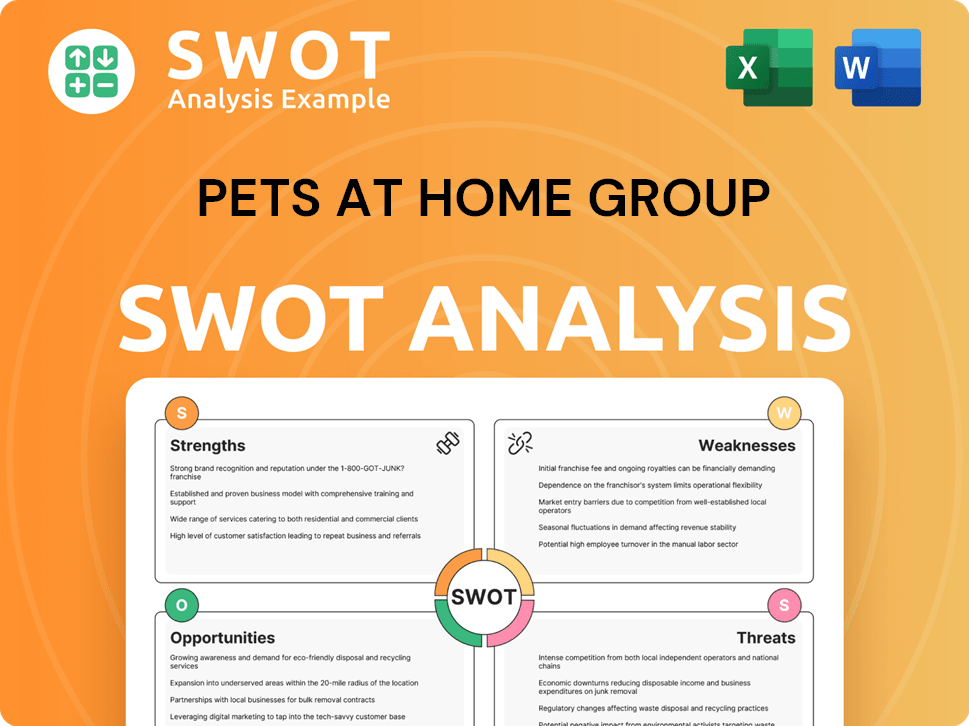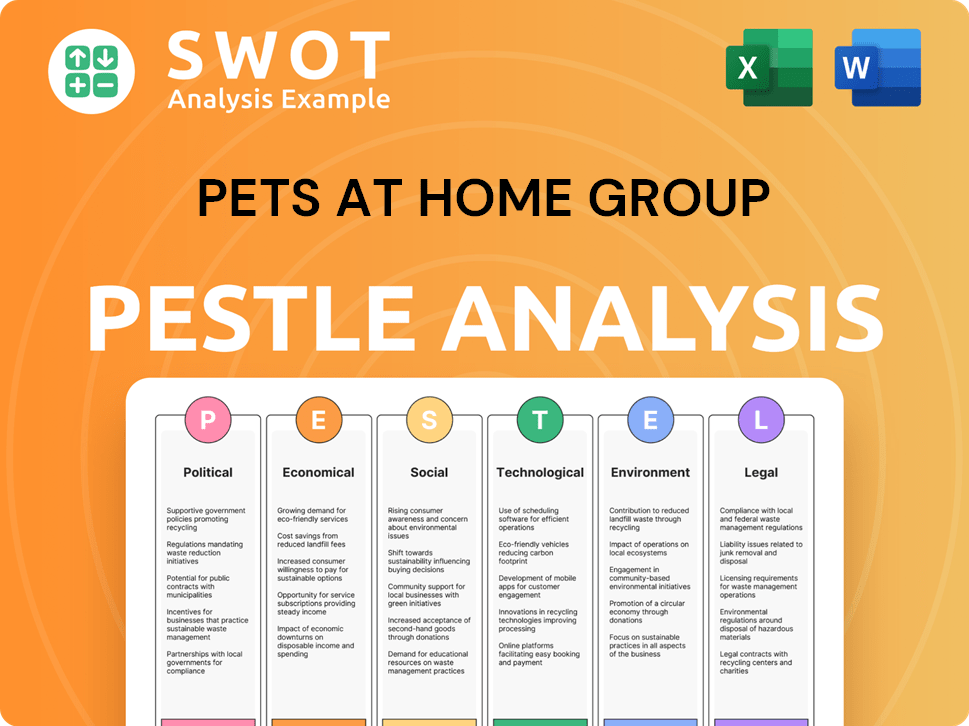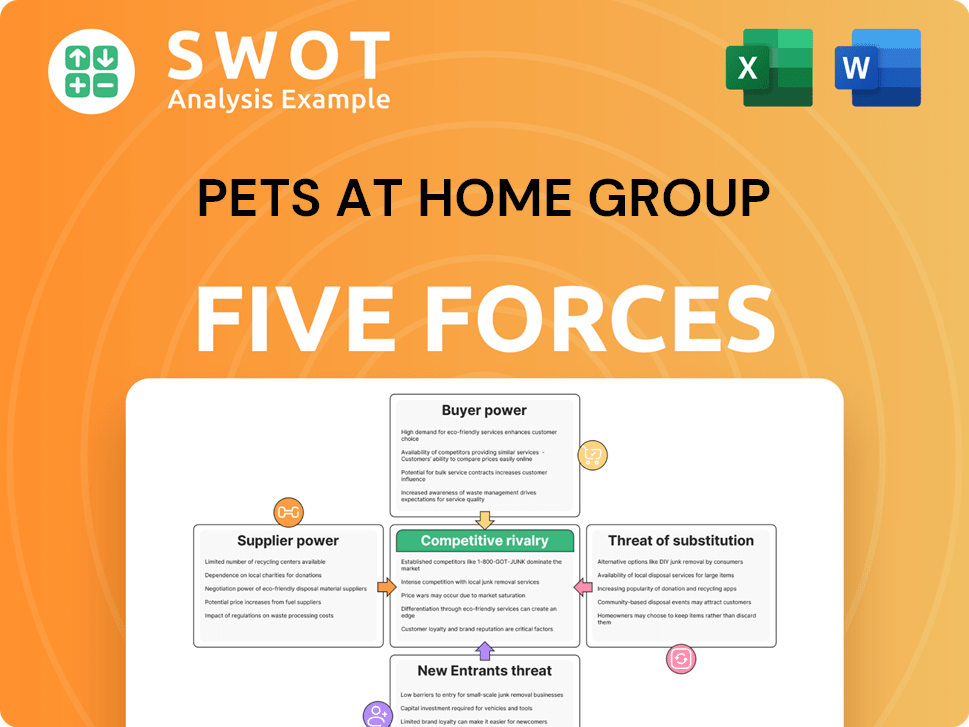Pets at Home Group Bundle
How Did Pets at Home Become a UK Pet Care Giant?
Embark on a journey through the remarkable Pets at Home Group SWOT Analysis, a company that transformed the UK pet market. From its inception as a single store, Pets at Home has redefined how we care for our furry, scaly, and feathered companions. Discover the key milestones that propelled this retail pet store to the forefront of the pet supplies industry.

The brief history of Pets at Home reveals a story of strategic vision and relentless growth. Founded in 1991, the company quickly recognized the potential of the UK pet market, expanding its services to include veterinary practices and grooming salons. Understanding Pets at Home's early years and its subsequent expansion history provides valuable insights into its enduring success and its ability to adapt to the ever-changing needs of pet owners.
What is the Pets at Home Group Founding Story?
The story of Pets at Home, a prominent player in the UK pet market, began on February 19, 1991. Founded by Anthony Preston, the company emerged from a vision to revolutionize the pet care industry. Preston's retail background was instrumental in shaping the business model.
Preston recognized a gap in the market, where pet owners faced the inconvenience of visiting multiple stores for their needs. His solution was a comprehensive, one-stop-shop approach, a concept that would define the company's early years and future growth. The initial focus was on providing a wide range of pet supplies and services.
The first Pets at Home store opened in Chester, serving as a prototype for the large-format pet superstore model. This innovative approach offered an extensive product range, including food, toys, and accessories, along with services like grooming and veterinary care. The company's name, 'Pets at Home,' reflected its commitment to creating a welcoming environment for pets and their owners. Initial funding came from Preston's personal investment and early loans, laying the foundation for its growth.
Key milestones in Pets at Home's early years.
- 1991: Anthony Preston founded Pets at Home.
- Early 1990s: The company focused on establishing its large-format store model across the UK.
- Early Expansion: Pets at Home expanded its store network, focusing on strategic locations to increase market share.
- Product and Service Diversification: The company broadened its offerings to include grooming and veterinary services.
Pets at Home Group SWOT Analysis
- Complete SWOT Breakdown
- Fully Customizable
- Editable in Excel & Word
- Professional Formatting
- Investor-Ready Format

What Drove the Early Growth of Pets at Home Group?
The early growth of Pets at Home Group was marked by a strategic focus on expanding its retail presence and diversifying its service offerings. Following the success of its initial store, the company rapidly opened additional large-format stores across the UK, establishing a national footprint. This expansion was coupled with the introduction of a wider range of pet supplies and services, catering to the evolving needs of pet owners. This period laid the foundation for its future market dominance in the UK pet market.
Early expansion involved opening numerous large-format retail pet stores across the UK. This strategy aimed to create a strong national presence. The company focused on strategic store locations to maximize market reach and customer accessibility. By the early 2000s, Pets at Home had significantly increased its store count, solidifying its position as a leading retail pet store.
The company broadened its product range to include various pet supplies, such as food, accessories, and specialized diets. It also integrated pet grooming services within its stores. This diversification enhanced the 'one-stop shop' appeal, attracting a wider customer base. The introduction of in-store veterinary practices further strengthened its service offerings.
A key development was the integration of in-store veterinary practices, initially through partnerships and later under the 'Vets at Home' brand. This move provided essential health services alongside retail products. The combination of retail and veterinary services created a comprehensive pet care solution. This integration significantly boosted customer loyalty and drove revenue growth.
Early customer acquisition strategies focused on providing a wide selection, competitive pricing, and knowledgeable staff. The market reception was largely positive, as the integrated approach resonated with pet owners. Steady revenue growth was driven by increasing store numbers and a growing customer base. This growth trajectory established Pets at Home as a key player in the UK pet market.
Pets at Home Group PESTLE Analysis
- Covers All 6 PESTLE Categories
- No Research Needed – Save Hours of Work
- Built by Experts, Trusted by Consultants
- Instant Download, Ready to Use
- 100% Editable, Fully Customizable

What are the key Milestones in Pets at Home Group history?
The Pets at Home history is marked by significant growth and strategic shifts within the UK pet market. The company's journey includes key acquisitions, expansions, and adaptations to meet evolving consumer demands in the pet supplies and services sector.
| Year | Milestone |
|---|---|
| 2004 | Acquired by KKR, marking a significant financial transaction in the company's history. |
| 2010 | Re-acquired by Bridgepoint, reflecting a change in ownership and investment strategy. |
| 2014 | Successful IPO, which provided capital for expansion and strategic initiatives, solidifying its position in the retail pet store industry. |
| Ongoing | Continuous expansion of store locations and service offerings, including veterinary practices, to meet the growing demand for pet care. |
One of the most significant innovations was the integration of veterinary services directly within the retail environment. This approach, starting with 'Vets at Home' and evolving into 'Companion Care' and 'Vets4Pets,' provided a unique selling proposition. This model enhanced customer convenience and created a comprehensive pet care ecosystem, driving footfall and revenue.
The introduction of in-store veterinary practices, a pioneering move that set the company apart. This integration offered pet owners convenient access to veterinary care within the retail setting.
Investing in omnichannel capabilities to integrate online and in-store experiences. This strategy catered to changing customer expectations, providing a seamless shopping experience.
Implementation of robust customer loyalty programs to encourage repeat business. These programs helped to build customer loyalty and increase the lifetime value of customers.
Focus on optimizing the supply chain to improve efficiency and reduce costs. This optimization ensured product availability and efficient distribution across its store network and online platform.
Forming strategic partnerships to expand service offerings and reach a wider customer base. These partnerships helped to enhance its service portfolio and customer value.
Adoption of technological advancements to improve operational efficiency and customer experience. This included investments in point-of-sale systems and customer relationship management tools.
The company has faced challenges from economic downturns impacting consumer spending. Competition from online retailers and supermarkets also presented a significant hurdle. Adapting to these challenges required strategic pivots and investments.
Economic downturns impacted consumer spending on discretionary pet items, requiring the company to adjust its product offerings and pricing strategies. This necessitated careful management of inventory and promotions.
Increasing competition from online retailers and supermarkets required continuous adaptation. This involved investing in omnichannel capabilities and enhancing the online shopping experience.
Challenges related to the integration of acquired veterinary practices and ensuring consistent service quality across a growing estate. This required robust training programs and quality control measures.
Navigating supply chain disruptions and ensuring product availability. This involved diversifying suppliers and implementing effective inventory management systems.
Adapting to changing consumer preferences and demands in the pet care market. This required the company to stay informed about market trends and adjust its product offerings accordingly.
Maintaining product-market fit in a rapidly evolving retail landscape required continuous adaptation. This involved regular market analysis and adjustments to product offerings and marketing strategies.
Pets at Home Group Business Model Canvas
- Complete 9-Block Business Model Canvas
- Effortlessly Communicate Your Business Strategy
- Investor-Ready BMC Format
- 100% Editable and Customizable
- Clear and Structured Layout

What is the Timeline of Key Events for Pets at Home Group?
The Pets at Home history is marked by strategic growth and adaptation within the UK pet market. Founded in 1991 by Anthony Preston, the company has evolved from a single store to a leading retail pet store, expanding its services and offerings over the years. Key milestones include acquisitions, such as Vets4Pets in 2015, and its successful listing on the London Stock Exchange in 2014. The company has consistently invested in its digital platforms and omnichannel retail experiences, alongside the strategic integration of retail and veterinary operations.
| Year | Key Event |
|---|---|
| 1991 | Anthony Preston founded Pets at Home, opening its first store in Chester. |
| 2004 | The company was acquired by the private equity firm KKR. |
| 2010 | Bridgepoint, another private equity firm, acquired Pets at Home. |
| 2014 | Pets at Home successfully listed on the London Stock Exchange. |
| 2015 | Vets4Pets, a veterinary group, was acquired, expanding veterinary services. |
| 2018 | The 'VIP Club' loyalty program was launched, gaining millions of members. |
| 2020 | Experienced significant sales growth due to a surge in pet ownership during the COVID-19 pandemic. |
| 2022 | Continued investment in digital platforms and omnichannel retail experiences. |
| 2023 | Announced a strategic focus on integrating retail and veterinary operations. |
| 2024 | Reported robust financial performance with continued growth in both retail and services. |
Pets at Home Group is focused on further integrating its retail and veterinary businesses. This holistic approach aims to create a seamless customer journey. They are enhancing digital platforms for better online and in-store experiences.
The company is investing in its digital platforms to improve online sales. This includes improving the user experience and expanding its omnichannel capabilities. This strategy aims to meet evolving consumer expectations.
Expanding veterinary practices is a key part of Pets at Home's strategy. The veterinary segment offers higher margins and recurring revenue. This expansion is a significant driver for future growth.
Pets at Home is committed to investing in technology and data analytics. This will help personalize customer experiences. The goal is to optimize operations and improve customer engagement.
Pets at Home Group Porter's Five Forces Analysis
- Covers All 5 Competitive Forces in Detail
- Structured for Consultants, Students, and Founders
- 100% Editable in Microsoft Word & Excel
- Instant Digital Download – Use Immediately
- Compatible with Mac & PC – Fully Unlocked

Related Blogs
- What is Competitive Landscape of Pets at Home Group Company?
- What is Growth Strategy and Future Prospects of Pets at Home Group Company?
- How Does Pets at Home Group Company Work?
- What is Sales and Marketing Strategy of Pets at Home Group Company?
- What is Brief History of Pets at Home Group Company?
- Who Owns Pets at Home Group Company?
- What is Customer Demographics and Target Market of Pets at Home Group Company?
Disclaimer
All information, articles, and product details provided on this website are for general informational and educational purposes only. We do not claim any ownership over, nor do we intend to infringe upon, any trademarks, copyrights, logos, brand names, or other intellectual property mentioned or depicted on this site. Such intellectual property remains the property of its respective owners, and any references here are made solely for identification or informational purposes, without implying any affiliation, endorsement, or partnership.
We make no representations or warranties, express or implied, regarding the accuracy, completeness, or suitability of any content or products presented. Nothing on this website should be construed as legal, tax, investment, financial, medical, or other professional advice. In addition, no part of this site—including articles or product references—constitutes a solicitation, recommendation, endorsement, advertisement, or offer to buy or sell any securities, franchises, or other financial instruments, particularly in jurisdictions where such activity would be unlawful.
All content is of a general nature and may not address the specific circumstances of any individual or entity. It is not a substitute for professional advice or services. Any actions you take based on the information provided here are strictly at your own risk. You accept full responsibility for any decisions or outcomes arising from your use of this website and agree to release us from any liability in connection with your use of, or reliance upon, the content or products found herein.